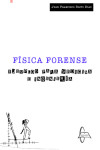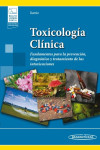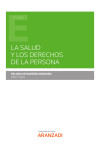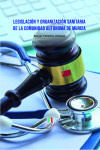PRACTICAL TOXICOLOGY. EVALUATION, PREDICTION, AND RISK
Woolley, D. - Woolley, A.
Producto agotado
Datos técnicos
- ISBN 9781498709286
- Año Edición 2017
- Páginas 528
- Encuadernación Rústica
- Idioma Inglés
Sinopsis
Practical Toxicology: Evaluation, Prediction, and Risk, Third Edition shows how to conduct a program of safety evaluation and testing and then to interpret and apply the resulting data and information in the real world, beginning with the basic concepts in toxicology and progressing to the interpretation of the resulting data. Revised and updated chapters on risk assessment guide the reader to setting the foundations necessary for submission to regulatory authorities. In addition, a new chapter in the book reviews the errors in toxicology, mistakes, misuse, mismanagement, and misunderstanding with a view to avoiding these in the future.
New Chapters in the Third Edition:
Toxicology in silico
Errors in Toxicology
Safety Assessment of Extractables and Leachables.
This new edition follows a practical sequence from introducing the basics of toxicology (including the vital concept of normality in controls) to describing a test program and then interpreting the data and translating that to risk assessment that can be used in a number of real world situations where safety and secure risk assessment are essential. Although written primarily from the perspective of pharmaceutical development, the test designs and toxicological problems encountered in that field are entirely relevant to those with other classes of chemicals, the only difference being the regulatory context. Toxicology is an international discipline and the book has been written to take into account some of the differences in regulatory nuance between the main regions of the world.
Completely revised and written in an easily accessible style, the text address several audiences—from students and post-graduates coming to the subject for the first time to established professionals who find themselves needing to learn about toxicology, toxicity testing, interpretation of the results, and risk assessment. It is intended primarily as a textbook, with case studies and information on where to go to ask questions, but can also be used as a practical reference book. It covers all the basics of toxicology and the main aspects of safety evaluation testing and risk assessment while reviewing critically the current state of the discipline. It also provides a foundation for those seeking registration or certification.
Features
Presents an easy-to-read introduction to the practical concepts of toxicology.
Delivers a broad review of test systems (in vitro, in silico, in vivo) with critical comments on pitfalls, deficiencies, and practicalities.
Offers guidance on practical risk assessment in various contexts and fields.
Provides a practical approach to toxicology from two authors who are active in regulatory toxicology.
Includes focus boxes and case studies to help the reader explore key concepts and examples.
Contents
Introduction to Toxicology: The Necessity of Measurement
Introduction
The Beginnings Of Toxicological Measurement
Toxicology And Toxicity Defined
It Is Natural So It Must Be Safe—Everyday Toxicological Conundrums
General Objectives Of Toxicological Study
Biology And Outcome Of Toxic Reactions
Cellular Basis And Consequences Of Toxic Change
Expression Of Toxicity
Target Organ Expression Of Toxicity
Ethics Of Toxicological Assessment
The Three Rs: Reduce, Refine, And Replace
References
Normality: Definition and Maintenance
Introduction
What Is Normality?
Normality As A Range
Experimental Normality
Control Groups As Normality
Establishing And Maintaining Normality In Experimental Groups
Baseline Data And Historical Controls
Summary
References
Determination of Toxicity: The Basic Principles
Introduction
Circumstances Of Toxicity Testing
Effects Sought In Toxicity Studies
Basic Principles Of Toxicological Investigation
Toxicokinetic Design
Regulatory Framework And Influences
Regulation Of Study Conduct—Good Laboratory Practice
Summary
References
Determination of Toxicity: In Vitro and Alternatives
Introduction
Rationale For In Vitro Toxicology
How And When To Use In Vitro Or Alternative Techniques
Considerations In Screening Program Design
Areas Of Use Of In Vitro Toxicology
Considerations In The Development Of In Vitro Tests
Validation Of In Vitro Methods
Test Systems And Endpoints
Target Organ Toxicity
Functional Toxicity Testing
Pharmacology And Safety Pharmacology In Vitro
Metabolism
Kinetics
Toxicity Testing
Carcinogenicity
Reproductive Toxicity
Sensitization
Irritation And Corrosion
Phototoxicity
Ecotoxicology
Pitfalls In In Vitro Toxicology
Omics
Future Utility
Summary
Toxicology in silico
Introduction
(Q)SAR Methodologies
Model validity
Regulations, QSARs And Experts
Case Study: ICH M7
Choosing A (Q)SAR
Commercial vs non-commercial
Pitfalls In In Silico Toxicology
Summary
Safety Pharmacology
Introduction
General Principles
Tests To Be Conducted
What To Test?
Design
Test Systems For Safety Pharmacology
Safety Pharmacology In Toxicity Studies
Tests And Their Conduct
Central Nervous System—Modified Irwin Screen
Cardiovascular System
Respiratory System
Gastrointestinal (Gi) Tract
Renal Function
Pitfalls Of Safety Pharmacology Studies
Summary
References
Determination: General and Reproductive Toxicology
General toxicology
Test systems for general toxicology
Study designs in general toxicology
Examinations for specific toxicities
Pitfalls in general toxicology
Reproductive and developmental toxicology
Study designs for reproductive toxicology
Pitfalls in reproductive toxicology
Summary
Determination: Genotoxicity and Carcinogenicity
Genotoxicity
General Principles in Genotoxicity
Test Battery and Study Design
Test Systems and Tests
Pitfalls in Genotoxicity
Genotoxicity Testing In Vitro—Sensitivity and Specificity
Carcinogenicity
General Principles In Carcinogenicity
Test Systems for Carcinogenicity
Study Design and Methods of Assessment
Choice of Dose Levels
Parameters Measured
Other Systems for Carcinogenicity Assessment
Pitfalls In Carcinogenicity Studies
Overview of the Future of Carcinogenicity Assessment
Summary
Determination: Dermal Toxicity—Sensitization, Irritation, and Corrosion
Introduction
General principles of dermal toxicology
Factors in dermal toxicity
Test systems
Study design and parameters measured
Dermal Irritation and Corrosion
Ocular Irritation
Irritation by Other Routes
Sensitization
Allergic Sensitization in Guinea Pigs
Allergic Sensitization in Mice (Local Lymph Node Assay)
Pitfalls in irritation and sensitization
Summary
Determination: Environmental Toxicology and Ecotoxicology
Introduction
Relevance of environmental assessment to chemical development
General principles of environmental toxicology and ecotoxicology
Pollution, routes of entry, and environmental ADME
Factors in testing for environmental effect
Test systems and study types for ecotoxicology
Ecotoxicology In Vitro
Invertebrates
Mesocosms and Field Tests and Studies
Environmental assessment of agrochemicals
Environmental assessment of pharmaceuticals
Pitfalls in environmental toxicology
Summary
References
Interpretation: Basic Principles
Introduction
The Interpretation Challenge
The Scope of Interpretation
Interpretation as a Dynamic Process
Steps In Interpretation
Study Design
Controls and Expectation
Use of Background Data in Interpretation
Statistics and Significance in Toxicology
Statistical Process
Data Treatment and Transformation
Assessing Exposure
Integration of Exposure Information
Toxicokinetics
The Reality of Difference—the interpretation of small differences
The Reproducibility of Difference
Summary
Interpretation: Different Data Types
Individual Data Sets
Safety Pharmacology
General Toxicology
Toxicokinetics
Clinical Pathology
Morphological Pathology
The Cell
Subcellular Organelles
Composition Of The Cytoplasm Or Cell Contents
Plasma Membrane Changes
Hypertrophy And Atrophy
Hyperplasia And Metaplasia
Changes To Whole Tissues Or Organs
Inflammation
Changes In Blood Supply
Repair And Reversibility
Neoplasia
Overview Of Interpretation In General Toxicology
Reproductive Toxicology
Genotoxicity
Carcinogenicity
Environmental Toxicology And Ecotoxicology
Epidemiology And Occupational Toxicology
Epidemiology
Occupational Toxicology
Case Study: Ciprofibrate
Summary
References
Prediction of Hazard
Introduction
Principles of prediction
Steps in the prediction process
Prediction from minimal databases
Pediction for individuals
Summary
Background to Risk Due to Toxicity
Introduction
Overview of risk analysis
Levels of risk and factors that affect risk
Risk perception
Acceptability and tolerability of risk
Comparative risk
Synthetic versus natural
Risk expression and quantification
Summary
References
Risk Assessment in Practice and Setting Exposure Limits
Introduction
Risk Assessment As A Process
Data Quality
Data Selection For Risk Assessment
Single Effect Versus General Risk Assessment
Tools And Models In Risk Assessment
Pbpk Models And Scaling
Models For Rodent Bioassay Data
Target Population, Dose, And Exposure
Prediction Of Exposure
Measurement Of Exposure
Process And Factors In Risk Assessment
Physical Form And Formulation
Route Of Exposure
Bioavailability
Dose Response
Safety Evaluation And Human Data
Purpose And Target Population
Setting Safety Factors And Margins
Hazard Weighting And Safety Factors
Safety Factor Rationale
Exposure Limits
Dose Level Selection For Starting Risk Assessment
Noel And Noael
The Benchmark Dose
Setting Exposure Limits
Use Of The Therapeutic Dose For Setting Wels/Oels For Pharmaceuticals
Thresholds Of Toxicological Concern
Summary
References
Safety Assessment of Extractables, Leachables and Impurities
Introduction
Definitions
Regulatory background
Toxicological assessment
Risk assessment
impurities in practice
Summary
References
Risk Assessment and Management in the Workplace
Introduction
Factors In Workplace Risk Assessment
Workplace Risk Assessment
Workplace Exposure Assessment
Risk Management In The Workplace
Summary
Risk Assessment: Carcinogenicity, the Environment, Evolution, and Overview of Risk Assessment
Introduction
Risk Assessment And Carcinogenicity
Risk Assessment And The Environment
International Management Of Environmental Risks
The Evolution Of Risk Assessment
Summary
Evaluation of Specific Classes of Chemical
Introduction
Regulatory Influences
The Basic Toxicity Test Package
Human Pharmaceuticals
Veterinary Pharmaceuticals
Medical Devices
Agrochemicals/Plant Protection Products
Biocides
Cosmetics
General And Industrial Chemicals—Reach
Tobacco Products
Summary
References
Errors in toxicology
Introduction
Errors through the ages
A brief history of early regulations
Modern mistakes and mismanagement
Clinical trials with new medicinal products
Contamination
Misunderstanding
The public and toxicology
Summary
References
The Future of Toxicity Testing and Risk Assessment
Introduction
Challenges For Toxicology
Evolution Of Toxicity Testing
Development Of New Test Methods And Models
The Future Of Toxicity Testing
A New Paradigm For Safety Evaluation
What Will The Future Of Testing Look Like?
Challenges For Risk Assessment And Management
Evolution Of Risk Assessment
Summary
References
Otros libros que te pueden interesar
- ¿Quiénes somos?
- Gastos de envío
- Política de privacidad
- Políticas de devolución y anulación
- Condiciones Generales de contratación
- Contacto
2024 © Vuestros Libros Siglo XXI | Desarrollo Web Factor Ideas









